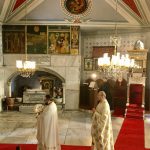“Ballad”
On the southern shore of the Golden Horn, Balat was once the heart of Jewish İstanbul and is home to the Ahrida Synagogue, one of the most beautiful of İstanbul’s surviving synagogues. Always poorer than neighbouring Fener, it is full of small terraced houses, some of them restored with money from a joint UNESCO-EU project. As in Fener the inland side of the coast road is still partially followed by pieces of the old Sea Walls that used to keep enemies out of the Golden Horn suburbs. It’s an area with many Byzantine, Jewish and Ottoman monuments that are relatively little known or visited.
In the 2010s Balat became extremely popular with TV and film crews including the one that shot the James Bond blockbuster, Skyfall. It also became a must-visit for Instagrammers in search of picturesque backdrops. The result has been extremely rapid touristification which often sits uncomfortably alongside ongoing pockets of poverty and poor housing. In the 2020s the local authority also started to repaint many of the houses in vibrant colours.
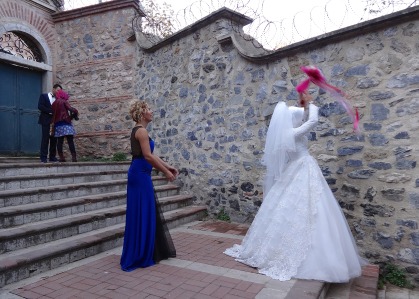 Tossing the bridal bouquet on Step StreetAround Balat
Tossing the bridal bouquet on Step StreetAround Balat
A stroll along Vodina Caddesi inside the Walls will take you past many of Balat’s sights and bring you eventually to its lively and inviting small market.
Soon you will come to Merdivenli Mektep Sokağı (“Step Street”) which heads uphill inland. At the foot of the steps is the house where the historian Dimitri Cantemir (1673-1723) lived for 20 years. Exiled to İstanbul as a teenager from his Moldavian homeland, Cantemir was a Greek philosopher and historian who wrote a History of the Growth and Decay of the Ottoman Empire, which remains an important source of information for the years 1688 to 1710. He also translated the Koran into Greek and wrote a treatise on Ottoman music. As the Prince of Moldavia, Cantemir fought alongside Peter the Great of Russia against the Ottomans. Following their defeat in 1711, he ended his life in Moscow. Despite EU-funded restoration there’s no sign of the house ever actually being open to the public.
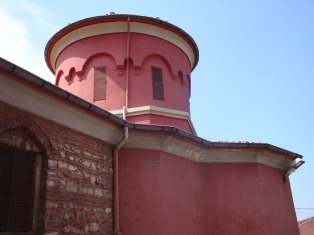 If you continue up the steps and turn right at the top you will come to the Byzantine Church of Panagia Muhlitotissa, more commonly known as St Mary of the Mongols. This is the only Byzantine church in the city to have stayed in Greek hands throughout the ages and to retain its original shape – not that this is particularly obvious from the outside which has been subjected to somewhat insensitive restoration that makes it look less Byzantine than many of the churches that were turned into mosques. It’s open to visitors on Sundays.
If you continue up the steps and turn right at the top you will come to the Byzantine Church of Panagia Muhlitotissa, more commonly known as St Mary of the Mongols. This is the only Byzantine church in the city to have stayed in Greek hands throughout the ages and to retain its original shape – not that this is particularly obvious from the outside which has been subjected to somewhat insensitive restoration that makes it look less Byzantine than many of the churches that were turned into mosques. It’s open to visitors on Sundays.
An old schoolhouse and yemekhane (canteen) still survive nearby, the latter in ruins.
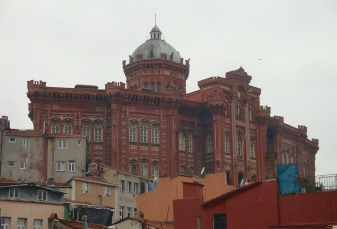 There are great views of the redbrick Fener High School for Boys from near St Mary of the Mongols. Afterwards if you return to Vodina Caddesi and continue eastwards you will pass a walled compound behind which stand the remains of two churches: Hagios Georgios (St George) and Panagia Paramithas (St Mary the Comforter), the latter also known as the Vlach Saray (Wallachian Palace) because it seems to have belonged to the Cantacuzenos family who regularly served as governors of Wallachia.
There are great views of the redbrick Fener High School for Boys from near St Mary of the Mongols. Afterwards if you return to Vodina Caddesi and continue eastwards you will pass a walled compound behind which stand the remains of two churches: Hagios Georgios (St George) and Panagia Paramithas (St Mary the Comforter), the latter also known as the Vlach Saray (Wallachian Palace) because it seems to have belonged to the Cantacuzenos family who regularly served as governors of Wallachia.
On the waterside of the Walls you will find a string of restored brick mansions with, behind them, the appallingly restored Church of Hagios Ioaanis Prodromos (St John the Baptist) built in 1830 on a site that had probably been occupied by a church since the 14th century and that was part of a metochion (embassy church) associated with the monastic church of St Catherine’s in Sinai, Egypt. Two of the battered buildings were once a library and guesthouse belonging to the church while the one facing the main road was the private mansion of a 17th-century politician named Panagotaki Nikosi. 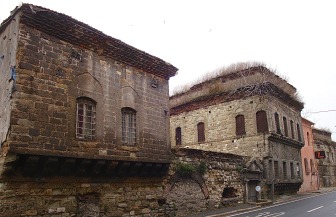 Metochion buildings
Metochion buildings
As Vodina Caddesi finally arrives at Balat market an unexpected Sinan mosque crops up. The simple Ferruh Kethüda Cami was built in 1562 and used to provide the setting for meetings of one of İstanbul’s four religious courts. Sadly, its portico has been glassed-in with little regard for the original architectural concept.
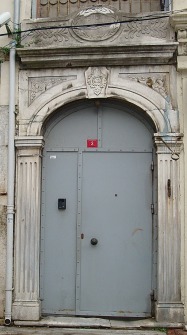 Entrance to Yanbol SynagogueAs you walk through the market look out for the locked gate of the Yanbol Synagogue built in 1895 for a Bulgarian congregation. Very occasionally it is opened to the public, revealing a stunning interior.
Entrance to Yanbol SynagogueAs you walk through the market look out for the locked gate of the Yanbol Synagogue built in 1895 for a Bulgarian congregation. Very occasionally it is opened to the public, revealing a stunning interior.
Nearby is the Ahrida Synagogue, whose congregation arrived in the city from Ohrid in Macedonia in the 15th century. The current building dates back to 1694 and features a dome that could not be seen from outside as well as a wooden bema (pulpit) possibly designed to evoke Noah’s Ark. To visit you need advance permission from the Rabbinate in Galata. You are unlikely to receive a warm welcome.
Not far away in Kamış Caddesi is the much larger and more conspicuous Armenian Church of Surp Hreşdagabed (the Archangels), built in 1835 on the site of a Greek Orthodox church going back to the 13th century but that was given to the Armenians in 1627. It stands on the site of an ayazma (sacred spring) dedicated to St Anthony. It’s well worth taking a look inside. The church used to be known for an annual service involving cockerel sacrifices that was attended by both Christians and Muslims in search of miracles. However, a blaze of publicity proved too much and the services have been cancelled; they live on now in the pages of Tim Kelsey’s travelogue, Dervish. The warehouse adjoining the church was originally the schoolhouse for the Armenian community.
Back on the waterfront you will come to an area where more of the old Sea Wall has survived. A modern memorial commemorates the start of the siege of the city in 1453. In solitary splendour on the water side of the road stands the stately Or-Ahayim Jewish Hospital designed by Gabriel Tedesçi in 1899.
If you walk back inside the wall you will come to the 18th-century Greek Orthodox Church of Hagios Demetrios Kanabu and then to the 19th-century Church of Panagia Balinu. Neither is of any great architectural significance.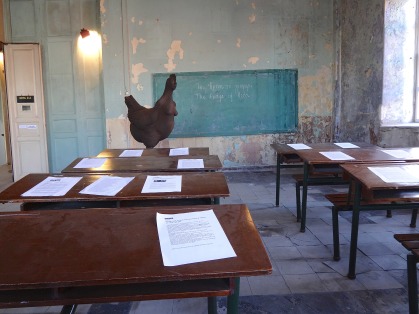 Schoolhouse of St Mary of the Mongols used to exhibit sculpture by Kalliopi Lemos during Biennale
Schoolhouse of St Mary of the Mongols used to exhibit sculpture by Kalliopi Lemos during Biennale
Eating
Balat has become Coffee Central for the old city, with every other building competing to serve up caffeine with a twist. One of the most interesting places to get your fix is İlter’s Coffee which is housed in a old Jewish mansion on Vodina Caddesi. It has a grand hallway and several floors of cafe culminating in a terrace with a magnificent view not just of the Golden Horn but also of the Greek High School in Fener with St Mary of the Mongols right beside it.
Transport info
A tram runs from Eminönü to Balat passing through Fener. Frequent buses from Eminönü and Taksim also run along the Golden Horn coast road although they often get stuck in traffic.
Ferries from Üsküdar, Kadıköy and Karaköy also serve Balat, if somewhat infrequently.
Nearby areas
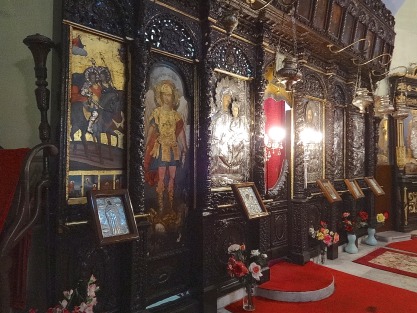 Interior of St Mary of the Mongols
Interior of St Mary of the Mongols


